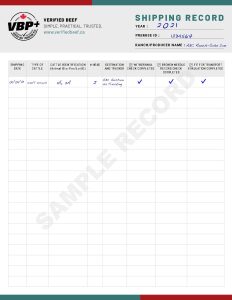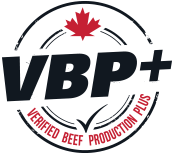
The fall run is not just a busy time of year for auction marts. For cow-calf and feedlot producers, fall is a mad dash of buying and selling. At times like this, it becomes hard to remember some key points related to food safety and animal care that become relevant when shipping calves or other cattle. Luckily, this problem can be easily solved with the help of a shipping record.
The VBP+ Shipping Record template is a single checklist that producers can go through when preparing a load of cattle for shipment. By filling out the document completely, producers can rest assured that they have done their part in ensuring high-quality animal care and food safety. Transportation and entry into the food chain are the points where consumers who are not connected to agriculture have the greatest chance to observe what producers do. So, it is important to make sure that what the public sees is Canadian beef producers’ commitment to these principles.
The top of the shipping record includes three important pieces of information. The year helps producers keep shipping records organized over time. Since the document has several rows, most producers can use only one or two of these sheets per year by recording all of their loads on one document. The premise ID is important for traceability purposes. In the event that an issue is discovered with an animal later on in the food chain, the Canadian Food Inspection Agency can use this record to trace the issue back to the premises of origin and prevent further hazards from entering the food chain. Finally, while the ranch/producer name might seem obvious to the recorder, this identification helps make this document useful proof of attention to the checks included in the record.
The next three columns help the producer associate the checks contained in the record with specific animals from their herd. The type of cattle column allows the producer to indicate the general class of cattle being shipped. This column is useful for quick reference when looking back on the record. For example, writing “weaned calves” in this column would help the producer remember that they had completed the shipping record when shipping their calves in the fall after weaning.
Similarly, the cattle identification column lets a producer narrow down which cattle they are referring to in the record. This specificity is important because it ensures that the three important checks in the last columns of the record are actually associated with the cattle being shipped. This identification can apply to single animals in the case of small loads or refer to groups of cattle using the producer’s own identification systems. The number of head allows for verification that the number of cattle that end up on the truck matches the number of cattle which were confirmed for safe shipment using the shipping record.
Recording the destination and trucker further aids in traceability in case an issue arises down the line. This column adds another pin on the map of where cattle move in their lifetime, helping officials track down the source of a problem should one come up. The trucker information is important for this same reason, as well as to have a record of the verification of a safe shipment before transferring care of the livestock from producer to trucker.
The final three columns are the “meat and potatoes” of the shipping record. These columns provide proof that a producer has done their due diligence in three key areas of responsible production. Firstly, indicating withdrawal check completed with a check mark shows that the producer has reviewed other records to confirm that the cattle in the shipment are not in a withdrawal period for an animal health product. While checking treatment records for the animals in the shipment is an obvious step, it is also important to think of other records linked to withdrawals, such as documentation of herbicide or pesticide usage. If animals grazed on pasture with a particular chemical, they may be subject to withdrawal for this reason as well. For cow-calf producers, it is important to note that animals may be shipped to a feedlot while still on withdrawal provided that their withdrawal information is sent to the feedlot operator along with them. This step will allow the feedlot operator to assume responsibility for ensuring that residues will not end up in carcasses.
The broken needle record check column is similar to the previous column in that it directs the producer to refer to a different document. The producer checks this box to indicate that they have reviewed records of broken needle occurrences on farm and confirmed that none of the animals in the shipment were involved in a broken needle incident. If cattle have broken needles, they should be retained for own consumption and the processor can be made aware of the location of the broken needle.
The final column verifies the fit for transport evaluation. This section requires the producer to observe the cattle in the shipment to verify that each individual can be safely transported without risk to animal welfare. In short, an animal is fit for transport if it can be expected to arrive at its destination in good condition. Lameness, injuries, and disease are all factors that can classify animals as either compromised, requiring transport with special provisions, or unfit for transport. Animals that are unfit for transport cannot be transported unless for veterinary diagnosis or care. The National Farm Animal Care Council (NFACC) Code of Practice for the Care and Handling of Beef Cattle contains a decision tree to help producers distinguish between these classes. This resource is also available within the Vulnerable, Distressed, and High-Risk Cattle section of the VBP+ Producer Reference Manual.
Shipping records are one of the key critical control points for producers to attend to in protecting food safety and animal care standards. This sample record, as well as a blank template for producer use, can be found under the Producer Resources section of our website.



